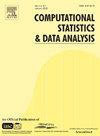Gamma approximation of stratified truncated exact test (GASTE-test) & application
IF 1.6
3区 数学
Q3 COMPUTER SCIENCE, INTERDISCIPLINARY APPLICATIONS
引用次数: 0
Abstract
The analysis of binary outcomes and features, such as the effect of vaccination on health, often rely on 2 2 contingency tables. However, confounding factors such as age or gender call for stratified analysis, by creating sub-tables, which is common in bioscience, epidemiological, and social research, as well as in meta-analyses. Traditional methods for testing associations across strata, such as the Cochran-Mantel-Haenszel (CMH) test, struggle with small sample sizes and heterogeneity of effects between strata. Exact tests can address these issues, but are computationally expensive. To address these challenges, the Gamma Approximation of Stratified Truncated Exact (GASTE) test is proposed. It approximates the exact statistic of the combination of p-values with discrete support, leveraging the gamma distribution to approximate the distribution of the test statistic under stratification, providing fast and accurate p-value calculations, even when effects vary between strata. The GASTE method maintains high statistical power and low type I error rates, outperforming traditional methods by offering more sensitive and reliable detection. It is computationally efficient and broadens the applicability of exact tests in research fields with stratified binary data. The GASTE method is demonstrated through two applications: an ecological study of Alpine plant associations and a 1973 case study on admissions at the University of California, Berkeley. The GASTE method offers substantial improvements over traditional approaches. The GASTE method is available as an open-source package at https://github.com/AlexandreWen/gaste. A Python package is available on PyPI at https://pypi.org/project/gaste-test/
分层截断精确检验(gaste检验)的伽玛近似及其应用
二元结果和特征的分析,如疫苗接种对健康的影响,通常依赖于2 × 2列联表。然而,年龄或性别等混杂因素需要通过创建子表进行分层分析,这在生物科学、流行病学和社会研究以及元分析中很常见。传统的跨地层关联性测试方法,如Cochran-Mantel-Haenszel (CMH)测试,难以适应样本量小和地层间影响的异质性。精确的测试可以解决这些问题,但是计算成本很高。为了解决这些挑战,提出了伽玛近似分层截断精确(GASTE)检验。它近似p值与离散支持组合的精确统计量,利用伽马分布近似分层下测试统计量的分布,提供快速和准确的p值计算,即使不同层的影响不同。GASTE方法保持高统计功率和低I型错误率,优于传统方法,提供更敏感和可靠的检测。它计算效率高,扩大了精确测试在分层二值数据研究领域的适用性。GASTE方法通过两个应用得到了证明:高山植物关联的生态学研究和1973年加州大学伯克利分校招生的案例研究。GASTE方法比传统方法有了实质性的改进。GASTE方法可以在https://github.com/AlexandreWen/gaste上以开源包的形式获得。Python包可以在PyPI上获得,网址是https://pypi.org/project/gaste-test/
本文章由计算机程序翻译,如有差异,请以英文原文为准。
求助全文
约1分钟内获得全文
求助全文
来源期刊

Computational Statistics & Data Analysis
数学-计算机:跨学科应用
CiteScore
3.70
自引率
5.60%
发文量
167
审稿时长
60 days
期刊介绍:
Computational Statistics and Data Analysis (CSDA), an Official Publication of the network Computational and Methodological Statistics (CMStatistics) and of the International Association for Statistical Computing (IASC), is an international journal dedicated to the dissemination of methodological research and applications in the areas of computational statistics and data analysis. The journal consists of four refereed sections which are divided into the following subject areas:
I) Computational Statistics - Manuscripts dealing with: 1) the explicit impact of computers on statistical methodology (e.g., Bayesian computing, bioinformatics,computer graphics, computer intensive inferential methods, data exploration, data mining, expert systems, heuristics, knowledge based systems, machine learning, neural networks, numerical and optimization methods, parallel computing, statistical databases, statistical systems), and 2) the development, evaluation and validation of statistical software and algorithms. Software and algorithms can be submitted with manuscripts and will be stored together with the online article.
II) Statistical Methodology for Data Analysis - Manuscripts dealing with novel and original data analytical strategies and methodologies applied in biostatistics (design and analytic methods for clinical trials, epidemiological studies, statistical genetics, or genetic/environmental interactions), chemometrics, classification, data exploration, density estimation, design of experiments, environmetrics, education, image analysis, marketing, model free data exploration, pattern recognition, psychometrics, statistical physics, image processing, robust procedures.
[...]
III) Special Applications - [...]
IV) Annals of Statistical Data Science [...]
 求助内容:
求助内容: 应助结果提醒方式:
应助结果提醒方式:


